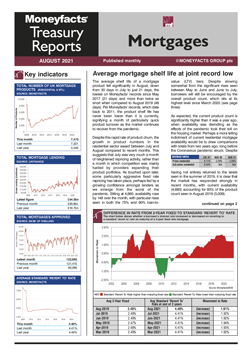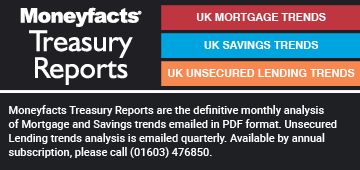Eleanor Williams, Finance Expert at Moneyfacts, said:
“The impact of the Bank of England base rate rise in December 2021 can start to be seen in the rate increases which have been passed on to term and two-year tracker average rates, which went up by 0.15% and 0.17% respectively month-on-month. However, the average standard variable rate (SVR) has so far seen a small 0.01% rise from 4.40% to 4.41% month-on-month. There may well be further increases to SVRs over the coming months, but the potential to save by switching from a variable revert rate to a fixed rate mortgage is clear, as the difference between the average two-year fixed rate and average SVR remains over 2%.
“As total product choice continues to improve to levels not seen in 13 years, the overall average two- and five-year fixed mortgage rates have increased again this month, marking their third consecutive rise. The two-year average fixed rate is currently 2.38% and the five-year equivalent sits at 2.66%, having seen slight rises of 0.04% and 0.02%. This echoes the trends recorded in previous months where the overall average rate rises can be attributed to increases across the rates offered at lower LTVs. Indeed, this month we recorded increases to all two-year fixed rates across the LTV brackets, with the exception of 95% and the niche 50% LTV sectors.
“Borrowers with a 5% deposit or equity may be very pleased to note that following drops of 0.03% and 0.06% to 3.06% and 3.33% respectively, the average two- and five-year fixed rates have fallen even further to reach another record low this month. In fact, the average two-year rate at 95% LTV is currently 1.38% less than the 4.44% that borrowers searching for an equivalent deal this time last year would have faced. Supporting recent analysis from Yorkshire Building Society, which noted that the number of first-time buyers had reached a 20-year high, our data illustrates that there are 339 more products on offer at 95% LTV than were available in January 2021. Following the end of the Stamp Duty holiday, it may be that this is a sector in which lenders are keen to continue competing for business, supported by the mortgage guarantee scheme which is set to run until the end of this year, and regardless of changes to base rate.
“With the potential for the Bank of England to apply further increases to the base rate in the coming months, there is no guarantee that the cost of borrowing on mortgages will not continue to rise overall. As the threat of rising inflation and potential for the cost of living to continue to rise and squeeze household budgets even more, there may be borrowers prompted to act sooner than perhaps they might have planned to in considering securing a new mortgage deal.”
Eleanor Williams, Finance Expert at Moneyfacts, said:
“The impact of the Bank of England base rate rise in December 2021 can start to be seen in the rate increases which have been passed on to term and two-year tracker average rates, which went up by 0.15% and 0.17% respectively month-on-month. However, the average standard variable rate (SVR) has so far seen a small 0.01% rise from 4.40% to 4.41% month-on-month. There may well be further increases to SVRs over the coming months, but the potential to save by switching from a variable revert rate to a fixed rate mortgage is clear, as the difference between the average two-year fixed rate and average SVR remains over 2%.
“As total product choice continues to improve to levels not seen in 13 years, the overall average two- and five-year fixed mortgage rates have increased again this month, marking their third consecutive rise. The two-year average fixed rate is currently 2.38% and the five-year equivalent sits at 2.66%, having seen slight rises of 0.04% and 0.02%. This echoes the trends recorded in previous months where the overall average rate rises can be attributed to increases across the rates offered at lower LTVs. Indeed, this month we recorded increases to all two-year fixed rates across the LTV brackets, with the exception of 95% and the niche 50% LTV sectors.
“Borrowers with a 5% deposit or equity may be very pleased to note that following drops of 0.03% and 0.06% to 3.06% and 3.33% respectively, the average two- and five-year fixed rates have fallen even further to reach another record low this month. In fact, the average two-year rate at 95% LTV is currently 1.38% less than the 4.44% that borrowers searching for an equivalent deal this time last year would have faced. Supporting recent analysis from Yorkshire Building Society, which noted that the number of first-time buyers had reached a 20-year high, our data illustrates that there are 339 more products on offer at 95% LTV than were available in January 2021. Following the end of the Stamp Duty holiday, it may be that this is a sector in which lenders are keen to continue competing for business, supported by the mortgage guarantee scheme which is set to run until the end of this year, and regardless of changes to base rate.
“With the potential for the Bank of England to apply further increases to the base rate in the coming months, there is no guarantee that the cost of borrowing on mortgages will not continue to rise overall. As the threat of rising inflation and potential for the cost of living to continue to rise and squeeze household budgets even more, there may be borrowers prompted to act sooner than perhaps they might have planned to in considering securing a new mortgage deal.”










